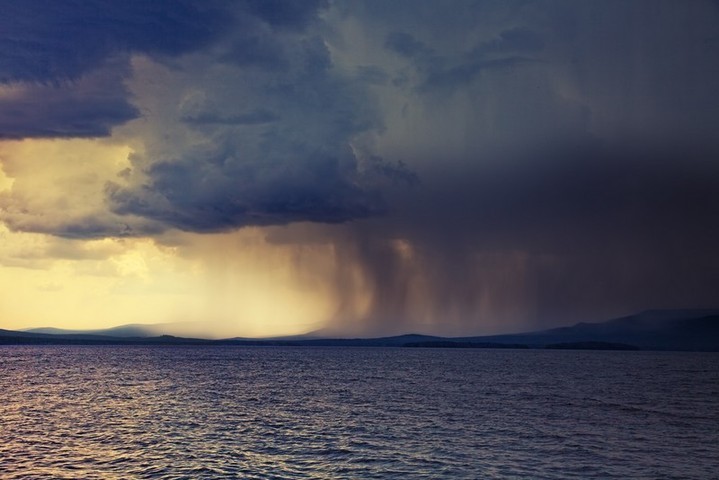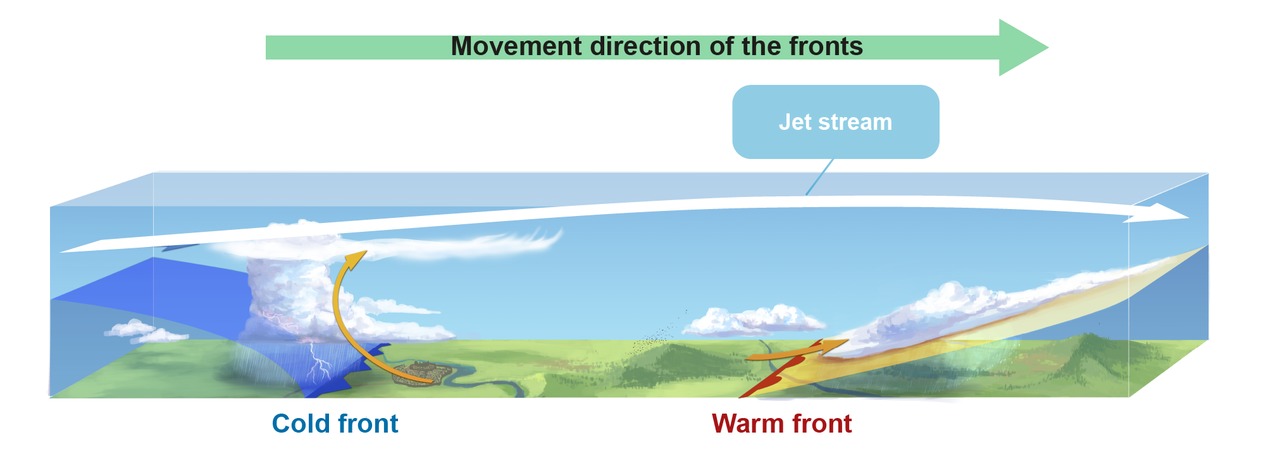9.3 Cyclones and the polar front
Near the planet's equator, where the amount of solar radiation is the highest, the air grows warmer continuously. This creates an area of constant low pressure. When this air rises it cools down and begins moving towards the south and the north.
In the planet's polar regions, the air cools down and forms areas of high pressure. Because differences in the atmosphere's air pressure always try to even themselves out, the air begins to flow away from the polar regions.
The warm and cold air currents meet each other near the 60th latitudes. The cold air mass will push beneath the warm air mass, creating an area of low air pressure. This results in the formation of the polar front.
When warm air is pushed below the cold air mass, the polar front grows bends that develop into large cliffs. These bends and cliffs are the sources of moving low pressure centers or cyclones. The polar front usually develops various low pressure centers, which move from the Atlantic towards different directions. In the weather map, these cyclones are marked with a "shark fin" symbol.
When these "shark fins" pass over a region, they change the weather conditions drastically. Cyclones bring warm and humid air to Finland from the Atlantic. This warm and humid air often spoils summer vacations and causes problems for the autumn harvest. The moving low pressure zone contains two fronts: the first front (or the Eastern front) is warm, whereas the second front (or the Western front) is cold.
 As the warm front closes in, the winds will grow stronger and large clouds will form in the horizon. These vast clouds result in a large zone of steady rain that can continue for a long time. After the warm front passes, the winds slow down and the sky will grow clear once again.
As the warm front closes in, the winds will grow stronger and large clouds will form in the horizon. These vast clouds result in a large zone of steady rain that can continue for a long time. After the warm front passes, the winds slow down and the sky will grow clear once again.
When the second, cold front closes in, the wind will once again grow stronger. Smaller clouds will form in the horizon. If these clouds produce rain, it will often be heavy, short and regional. After the cold front passes, the sky grows clear once again.
After the cold front has passed, the cycle will begin again with a new cyclone. The arrival of cyclones is easy to predict, as they generally move at a speed of approximately 50 kilometers per hour.
When cyclones do not pass through a region, the result is clear and sunny high pressure weather.

Cyclone. The first front consists of warm air and is followed by a second front consisting of cold air.
In the planet's polar regions, the air cools down and forms areas of high pressure. Because differences in the atmosphere's air pressure always try to even themselves out, the air begins to flow away from the polar regions.
The warm and cold air currents meet each other near the 60th latitudes. The cold air mass will push beneath the warm air mass, creating an area of low air pressure. This results in the formation of the polar front.
When warm air is pushed below the cold air mass, the polar front grows bends that develop into large cliffs. These bends and cliffs are the sources of moving low pressure centers or cyclones. The polar front usually develops various low pressure centers, which move from the Atlantic towards different directions. In the weather map, these cyclones are marked with a "shark fin" symbol.
When these "shark fins" pass over a region, they change the weather conditions drastically. Cyclones bring warm and humid air to Finland from the Atlantic. This warm and humid air often spoils summer vacations and causes problems for the autumn harvest. The moving low pressure zone contains two fronts: the first front (or the Eastern front) is warm, whereas the second front (or the Western front) is cold.
 As the warm front closes in, the winds will grow stronger and large clouds will form in the horizon. These vast clouds result in a large zone of steady rain that can continue for a long time. After the warm front passes, the winds slow down and the sky will grow clear once again.
As the warm front closes in, the winds will grow stronger and large clouds will form in the horizon. These vast clouds result in a large zone of steady rain that can continue for a long time. After the warm front passes, the winds slow down and the sky will grow clear once again. When the second, cold front closes in, the wind will once again grow stronger. Smaller clouds will form in the horizon. If these clouds produce rain, it will often be heavy, short and regional. After the cold front passes, the sky grows clear once again.
After the cold front has passed, the cycle will begin again with a new cyclone. The arrival of cyclones is easy to predict, as they generally move at a speed of approximately 50 kilometers per hour.
When cyclones do not pass through a region, the result is clear and sunny high pressure weather.

Cyclone. The first front consists of warm air and is followed by a second front consisting of cold air.